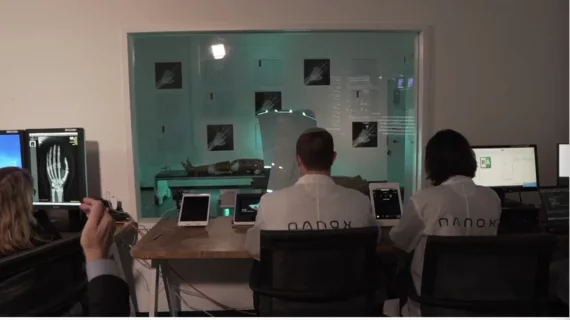Imaging startup Nanox livestreams its digital x-ray imaging capabilities during RSNA’s annual meeting
Medical imaging disrupter Nanox has arguably become one of the most controversial forces in radiology over the past year. But the startup has denied criticisms of its vision to offer widespread imaging access at a fraction of current prices.
Ran Poliakine, chairman and CEO of the Israeli company, sought to deliver on his past promise to crush “baseless” critiques during his live demonstration of the Nanox.ARC system on Thursday at RSNA’s annual meeting.
Livestreaming from Israel, Poliakine made no mention of past allegations, which include a disputed report from Citron Research and at least one class action lawsuit. He did, however, tout the firm’s ceramic digital x-ray tube that costs about $100 per unit compared to the up to $150,000 for today’s glass tubes.
During the Thursday morning video, he also successfully imaged his own wrist in real-time using a single-source Nanox.ARC system. Although he forgot to take off his metal bracelet, the exam was a success and took only seconds.
A lengthy portion of the nearly 30-minute presentation was also dedicated to comparing images of a phantom taken at Schneider Children’s Hospital in Israel to those produced with the same model using a Nanox machine. Aside from the wrist x-ray, none of those exams were conducted in real-time.
Board-certified radiologists Nogah Shabshin, MD, MBA, with Penn Medicine’s Department of Radiology, and Michael Yuz, MD, MBA, CEO of teleradiology firm USARAD and a Nanox advisor, both analyzed the images on workstation monitors.
“This is great quality,” Shabshin said, looking over the x-ray of Poliakine’s wrist. “It’s at least as good as the [images] I’m used to seeing in my daily practice.”
Investors appeared a little more skeptical of the demonstration, as Nanox saw its stock price drop more than 10% immediately after the presentation wrapped. During extended market hours, however, shares were up more than 1.5% on the day. On the year, shares are up more than 257%.
“Today we connected the dot between technology and radiologists,” Poliakine said during the livestream. “We are pleased to have now demonstrated a working prototype of our next generation digital x-ray technology, the Nanox.ARC, in a range of medical imaging procedures that produced unique clinical value,” he added in a statement about the event.
Nanox has not yet received any U.S. Food and Drug Administration approvals for its products, and it likely won’t win over many of its skeptics until it receives the green light.
Poliakine said his team has submitted its single-source system for 510(k) clearance and expects to hear back soon. On Thursday, during an investor call following the RSNA presentation, the CEO added that they are inching toward submitting the same documents for its full-body, multi-source machine in the coming “weeks to months."
The company currently has more than 5,150 preorders for its Nanox.ARC unit and maintains that it hopes to have 15,000 machines operational by 2024.

